Related Research Articles
Rear admiral is a senior naval flag officer rank, equivalent to a major general and air vice marshal and above that of a commodore and captain, but below that of a vice admiral. It is regarded as a two star "admiral" rank. It is often regarded as a two-star rank with a NATO code of OF-7.
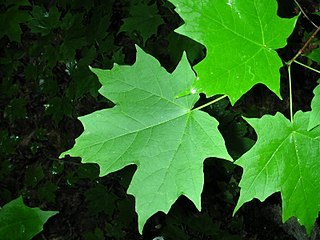
Acer saccharum, the sugar maple, is a species of flowering plant in the soapberry and lychee family Sapindaceae. It is native to the hardwood forests of eastern Canada, from Nova Scotia west through southern Quebec, central and southern Ontario to southeastern Manitoba around Lake of the Woods, and northcentral and northeastern United States, from Minnesota eastward to Maine and southward to northern Virginia, Tennessee and Missouri. Sugar maple is best known for being the primary source of maple syrup and for its brightly colored fall foliage. It may also be known as "rock maple", "sugar tree", "birds-eye maple", "sweet maple", "curly maple", or "hard maple", particularly when referring to the wood.
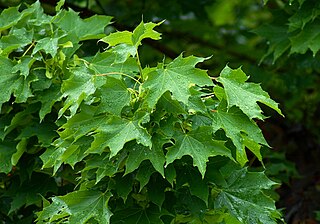
Acer platanoides, commonly known as the Norway maple, is a species of maple native to eastern and central Europe and western Asia, from France east to Russia, north to southern Scandinavia and southeast to northern Iran. It was brought to North America in the mid-1700s as a shade tree. It is a member of the family Sapindaceae.

Acer rubrum, the red maple, also known as swamp, water or soft maple, is one of the most common and widespread deciduous trees of eastern and central North America. The U.S. Forest service recognizes it as the most abundant native tree in eastern North America. The red maple ranges from southeastern Manitoba around the Lake of the Woods on the border with Ontario and Minnesota, east to Newfoundland, south to Florida, and southwest to East Texas. Many of its features, especially its leaves, are quite variable in form. At maturity, it often attains a height of around 30 m (100 ft). Its flowers, petioles, twigs and seeds are all red to varying degrees. Among these features, however, it is best known for its brilliant deep scarlet foliage in autumn.

Acer campestre, known as the field maple, is a flowering plant species in the family Sapindaceae. It is native to much of continental Europe, Britain, southwest Asia from Turkey to the Caucasus, and north Africa in the Atlas Mountains. It has been widely planted, and is introduced outside its native range in Europe and areas of USA and Western Australia with suitable climate.

Acer is a genus of trees and shrubs commonly known as maples. The genus is placed in the family Sapindaceae. There are approximately 132 species, most of which are native to Asia, with a number also appearing in Europe, northern Africa, and North America. Only one species, Acer laurinum, extends to the Southern Hemisphere. The type species of the genus is the sycamore maple, Acer pseudoplatanus, the most common maple species in Europe. The maples usually have easily recognizable palmate leaves and distinctive winged fruits. The closest relatives of the maples are the horse chestnuts. Maple syrup is made from the sap of some maple species.
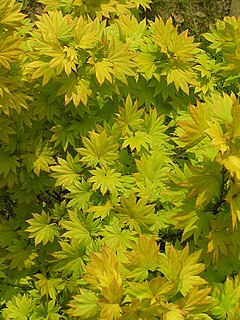
Acer shirasawanum, the Shirasawa maple or fullmoon maple, is a species of maple native to Japan, on central and southern Honshū, Shikoku, and Kyūshū.

Acer japonicum, the Amur maple, downy Japanese-maple or fullmoon maple, is a species of maple native to Japan, on Honshū, Hokkaidō, Kyūshū, and also southern Korea.

An officer of one-star rank is a senior commander in many of the armed services holding a rank described by the NATO code of OF-6. The term is also used by some armed forces which are not NATO members. Typically, one-star officers hold the rank of commodore, flotilla admiral, brigadier general, brigadier, or in the case of those air forces with a separate rank structure, air commodore.

Acer × zoeschense is a hybrid maple, a cross between Acer campestre, and either Acer lobelii or Acer cappadocicum. While Field Maple parentage is universally accepted, the second parent is uncertain, though the tree's extensive production of root sprouts favours A. cappadocicum over A. lobelii. It takes its name from Zöschen Nurseries in Germany, where it first appeared as a garden hybrid at some time before 1870.
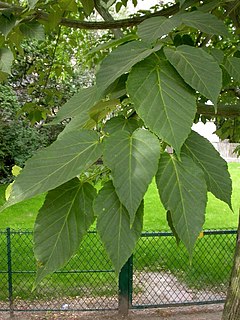
Acer davidii, or Père David's maple, is a species of maple in the snakebark maple group. It is native to China, from Jiangsu south to Fujian and Guangdong, and west to southeastern Gansu and Yunnan.
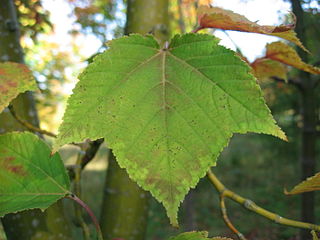
Acer rufinerve, the grey-budded snake-bark-maple, redvein maple or Honshū maple, is a species of tree in the snakebark maple group, related to Acer capillipes. It is native to mountain forests of Japan, on Honshū, Kyūshū and Shikoku.

Acer cissifolium is a maple native to Japan, from southern Hokkaidō south through Honshū and Shikoku to Kyūshū.
The elm cultivar Ulmus 'Rugosa' [:'wrinkled', the leaves], was first listed in Audibert's Tonelle (1817), as "U. campestris Linn. 'Rugosa' = orme d'Avignon [Avignon elm] ", but without description. A description followed in the Revue horticole, 1829. Green (1964) identified this cultivar with one listed by Hartwig and Rümpler in Illustrirtes Gehölzbuch (1875) as Ulmus montana var. rugosaHort.. A cultivar of the same name appeared in Loddiges' catalogue of 1836 and was identified by Loudon in Arboretum et Fruticetum Britannicum (1838) as Ulmus montana var. rugosaMasters, Masters naming the tree maple-bark elm. Ulmus montana was used at the time both for wych cultivars and for some cultivars of the Ulmus × hollandica group.

Weeping trees are characterized by soft, limp twigs. This characterization may lead to a bent crown and pendulous branches that can cascade to the ground. While weepyness occurs in nature, most weeping trees are cultivars. Because of their shape, weeping trees are popular in landscaping; generally they need a lot of space and are solitary so that their effect is more pronounced. There are over a hundred different types of weeping trees. Some trees, such as the cherry, have a variety of weeping cultivars. There are currently around 550 weeping cultivars in 75 different genera, although many have now disappeared from cultivation.
The Field MapleAcer campestre cultivar 'Eastleigh Weeping' or 'Weeping Eastleigh Field Maple' is a weeping tree that originated as a seedling at the Hillier & Son nursery, Ampfield, England, and was released in 1980. No trees are known to survive of this cultivar.

Acer palmatum, commonly known as Japanese maple, palmate maple, or smooth Japanese maple, is a species of woody plant native to Japan, Korea, China, eastern Mongolia, and southeast Russia. Many different cultivars of this maple have been selected and they are grown worldwide for their large variety of attractive forms, leaf shapes, and spectacular colors.

Åkerö, also called Akero or Okera, is an old apple cultivar of presumed Swedish origin, but possibly introduced from the Netherlands. It is a dessert apple with an aromatic flavor.
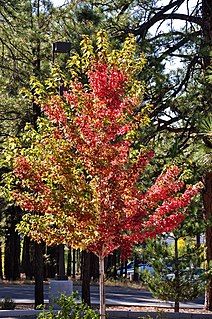
Acer × freemanii, Freeman maple or Freeman's maple, is a naturally occurring hybrid maple that is the result of a cross between Acer rubrum and Acer saccharinum. Wild specimens are found in eastern North America where the parent species overlap. The species is named for Oliver M. Freeman of the U.S. National Arboretum who hybridized A. rubrum with A. saccharinum in 1933. The fall foliage is a striking orange-red. It has many commercially available cultivars and is frequently used as a street tree.

Acer × conspicuum, called the snakebark maple, is a hybrid species of maple. It was created in the Netherlands by crossing Acer davidii with Acer pensylvanicum.
References
- ↑ van Gelderen, D. M., de Jong, P. C., and Oterdoom, H. J. (1994). Maples of the World. Timber Press, Oregon. ISBN 0-88192-000-2.